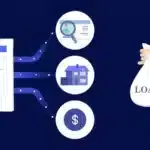The lending landscape in India has undergone a significant shift from traditional, paper-based processes to modern, digitized loan management systems. There is a reform in the lending landscape by using an LMS that improves borrowers’ experience and creates operational efficiencies beneficial for lenders. As lending transactions are becoming more complex, it is not the right choice to rely on labor-intensive processes involving more manual activities. There are always risks of human errors and inefficient time usage, further driving the need for loan management software. This is how Loan Management Software helps make work easier for the banks, NBFCs, and fintechs. Furthermore, it is automated and has many different features. In this article, we touch on the role the lending management software plays for the banks and lending firms, while the potential role they can play will lead to an easier lending process.
The market for loan management software was estimated to be worth $5.9 billion in 2021 and is expected to grow at a compound annual growth rate of 17.8% from 2022 to 2031, reaching $29.9 billion.
What are the issues with the manual or traditional lending operations?
- Manual lending processes are not able to handle the speed, workload load and current lending scenario.
- It involves a lot of paperwork that can lead to errors. Adding the buyer’s information manually at different stages increases the chances of informational errors.
- There is no support for third-party software that can make the whole process less time-consuming and error-free.
- The time for loan disbursement is very long due to a lot of paperwork.
How does Loan Management Software simplify lending for Banks and FinTechs by replacing manual processes?
Simplifies the loan origination process
Lending loans to the customers involves several steps, including the borrower’s information, verification, and authenticity of the documents, and many more. Previously, all the work was done manually. This led to frustration for the lenders and borrowers as it took many days to note down the information and then disburse the loan.
Loan management software collects information online, verifies it using AI-powered tools, completes KYC within seconds, and disburses loans in minutes.
For the banks, this means improved customer experience, quick onboarding of the borrowers, and less time consumption.
Reducing Human Errors
The whole loan originating process becomes automated, and this reduces the risk of manual errors. Manual errors can lead to financial losses and poor customer experience. When work is automated, there is no risk of manual errors in data entry, document verification, and tracking of the payments by the customers.
Loan management software keeps track of all the applications and provides timely reminders for any delayed payments, any false information, and other issues.
Fast loan Approvals
The loan management software centralizes all steps in the lending process, from calculating interest rates to assessing the borrowers’ creditworthiness—all under one platform. FinTechs and banks eliminate paperwork, allowing them to disburse loans faster and onboard more customers every day.
Scalability and Operational Costs
In the manual process of lending loans, one employee entertains many loan applications. It increases the load, and there is more operational cost involved. The traditional process is not scalable and cannot rescue the customer experience.
Using the LMS reduces the operational cost as software can handle multiple loan applications without the need to add extra workforce. It improves the customer experience and reduces the burden on the credit firms.
Data-Driven Decisions
There are larg volumes and transactions that are involved in the loan lending business daily. When you handle this data manually, there is a greater likelihood of mistakes and incorrect calculations. Loan management software uses comprehensive dashboards, moreover, to allow lenders to access real-time information on a borrower’s portfolio performance so they can make data-driven decisions.
Regulatory Compliance
Banks and fintech companies need to keep the regulatory compliance checks set by the higher authorities. The rules are hard to follow manually; furthermore, they can lead to financial losses for the companies. Compliance features in loan management software make sure your business aligns with regulatory requirements, from applying proper taxes and interest rates to performing anti-money laundering and fraud checks.
Conclusion
Loan Management Software Transforms Lending Operations for Banks and FinTechs in many different ways that we have mentioned above. Jaguar Software India is a company that provides you with loan management software solutions by improving the management of loan processes and, furthermore, improving the borrowing experience.
The company provides the creditworthiness checks, data stored centrally, rules and compliance, and easy integration with existing business tools. Our platform is built to enable your business growth. To know more about the solutions provided by Jaguar Software India, visit the website and check the services that help you get the best possible solutions for your needs.
Frequently asked questions
What is a loan management software?
It is a software that manages the loan application automatically. It reduces the loan disbursal time and improves the customer experience.
Which company provides the top loan management software solutions?
Jaguar Software India provides the top loan management solutions to customers.
Can we use LMS for a small business?
Both small and large businesses can use it effectively. This helps to overcome the challenges of manual loan disbursal.
Why is there a need for banks and NBFCs for the loan management software?
It makes them competitive against other loan lending companies. It streamlines the process and helps them to get more customers on board in easy time.
Is this loan management software AI-powered?
These AI-powered loan management systems process and analyze large volumes of data efficiently. This helps you to find the data easily and make better financial decisions.








